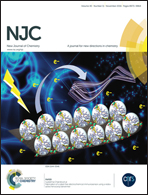Development of PANI/MWCNTs decorated with cobalt oxide nanoparticles towards multiple electrochemical, photocatalytic and biomedical application sites†
Abstract
In the present work, a ternary nanocomposite of Co3O4doped/PANI/MWCNTs (cobalt oxide-doped polyaniline multi-walled carbon nanotubes) was synthesized via the in situ oxidative polymerization of aniline. The composite was fully characterized using instrumental analysis, and further tested for its potential in electrochemical, photocatalytic and biomedical applications. The Co oxide nanoparticles were first synthesized using the sol–gel approach in the presence of starch as a capping agent so as to prevent agglomeration and characterized using Fourier transform infrared spectroscopy (FTIR), powder X-ray diffraction (XRD), scanning electron microscopy (SEM), EDX, elemental mapping and high-resolution transmission electron microscopy (HRTEM). For the measurement of electrochemical activity, the electrodes were synthesized with MWCNTs and functionalized with a conducting polymer (PANI). For the composite, the Co metal oxide provides a pseudo-capacitance which, in general, improves the performance characteristics of the electrode and has been the focus of many researchers. Further, the specific capacitance of the prepared composite was tested using cyclic voltammetry (CV) and impedance spectroscopy. The capacitive studies reveal that the composite has a synergistic effect and is observed to have the highest specific capacitance of 382 F g−1 run at a scan rate of 10 mV s−1. The composite was also found to have excellent photocatalytic degradation properties and outstanding antibacterial activity against both Gram positive and Gram negative bacterial strains. The minimum MIC (6.25 μg mL−1) and MBC (12.5 μg mL−1) values against E. coli and maximum values against B. amyloliquefaciens (25 and 50 μg mL−1) at fourth dilution were observed. Furthermore, the anticancer efficiency of the composite was tested by making use of two different cancer cell types (MCF-7 and MDA-MB-231) confirming the importance of its biological activity for biomedical applications.


 Please wait while we load your content...
Please wait while we load your content...